The Game-Changing Magic of Agile Scrum Retrospectives – In the dynamic landscape of project management and software development, where agility is key and adaptability paramount, Agile methodologies have become the cornerstone of success. At the heart of Agile lies the Scrum framework, a structured and iterative approach that empowers teams to deliver high-quality products incrementally. As organizations worldwide embrace the principles of Agile, the Scrum ceremonies play a pivotal role in ensuring collaboration, transparency, and continuous improvement.
While Sprint Planning, Daily Stand-ups, and Sprint Reviews often take the spotlight in discussions around Scrum ceremonies, there’s one that stands as the unsung hero, quietly influencing the trajectory of teams and projects – the Retrospective.
The Agile Philosophy and Continuous Improvement
Agile, fundamentally, is not just a set of practices but a philosophy that embraces change, values individuals and interactions, prioritizes working solutions, and fosters customer collaboration. A core tenet of Agile is the commitment to continuous improvement – the notion that even successful processes can be refined, and lessons learned can pave the way for enhanced performance.
Navigating the Scrum Framework
At the core of Agile methodologies is the Scrum framework, a framework that encapsulates roles, artifacts, and ceremonies designed to facilitate teamwork, adaptability, and iterative progress. Among these ceremonies, the Sprint Planning meeting sets the stage, Daily Stand-ups keep teams synchronized, and Sprint Reviews showcase accomplishments. Yet, it is the often-overlooked Retrospective that holds the key to unlocking sustained success.
The Overlooked Elegance of the Agile Scrum Retrospectives
The Retrospective, held at the conclusion of each sprint, represents a unique and invaluable opportunity for teams to introspect, learn, and evolve. This ceremony is not merely a formality but a strategic pause where the collective intelligence of the team converges to dissect the sprint’s nuances.
Unveiling the Unsung Hero: Agile Scrum Retrospectives
In this blog, we embark on a journey to unveil the unsung hero of Agile Scrum – the Retrospective. We will delve into the essence of Agile principles, understand the intricacies of the Scrum framework, and shed light on why the Retrospective, despite its critical role, often finds itself overshadowed.
As we explore the depths of the Retrospective ceremony, we will unravel common challenges faced by teams, propose strategies to overcome these hurdles, and showcase real-world examples of teams that have harnessed the power of retrospectives to transform their work dynamics and project outcomes.
Join us in this exploration of the often-neglected yet indispensable element of Agile methodologies. Let’s shine a spotlight on the Retrospective and understand how this ceremony, when given the attention it deserves, can be a catalyst for continuous improvement and innovation in the ever-evolving realm of Agile project management.
Chapter 1: The Essence of Agile Scrum Retrospective
Continuous Improvement as an Agile Pillar
Agile methodologies are grounded in the principle of continuous improvement, a concept that goes beyond mere iterations and sprints. At its core, Agile philosophy encourages teams to reflect on their processes, identify areas for enhancement, and iterate upon them in an ongoing cycle. The heartbeat of this relentless pursuit of improvement is the Agile Retrospective.
Defining the Agile Retrospective
The Agile Retrospective, often referred to as the “retro” is a dedicated ceremony that occurs at the end of each sprint or iteration. Unlike other Scrum ceremonies, the Retrospective does not focus on the work done but on how the work was done. It serves as a structured opportunity for the team to assess its performance, processes, and collaboration dynamics.
Objectives of the Retrospective
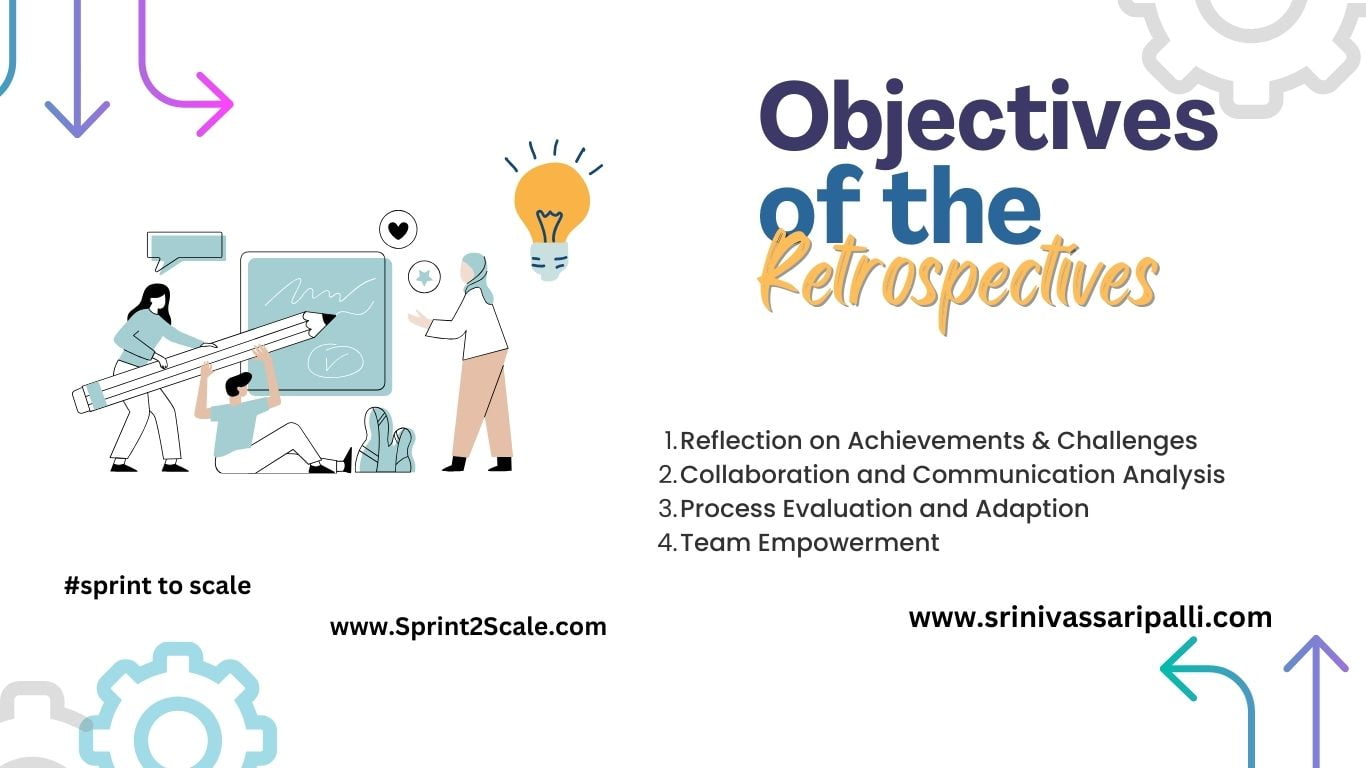
The primary goals of the Retrospective are multifaceted, aiming to foster a culture of continuous improvement within the team:
- Assessment of the effectiveness of Agile processes and practices.
- Identification of potential modifications to enhance efficiency.
| Reflection on Achievements and Challenges |
|
Collaboration and Communication Analysis |
|
Process Evaluation and Adaptation |
|
Team Empowerment |
|
1.4 The Ritual of the Retrospective
The Retrospective is not a one-size-fits-all affair; teams can adapt the ceremony to suit their unique context. However, the general structure often includes three key phases:
| Set the Stage |
|
| Gather Data |
|
| Generate Insights and Plan Action |
|
1.5 The Underestimated Power of Reflection
The Retrospective, sometimes overshadowed by the excitement of planning and the tangible results of reviews, is a quiet powerhouse for team development. It provides a structured mechanism for self-assessment, fostering a sense of ownership, accountability, and camaraderie among team members.
Chapter 2: Spotlight on the Retrospective
2.1 The Unsung Hero’s Identity
In the bustling world of Scrum ceremonies, the Retrospective stands out as the silent powerhouse, often underestimated in its impact. Unlike Sprint Planning that charts the course, Daily Stand-ups that synchronize efforts, or Sprint Reviews that showcase achievements, the Retrospective discreetly operates in the background, focusing on the process itself.
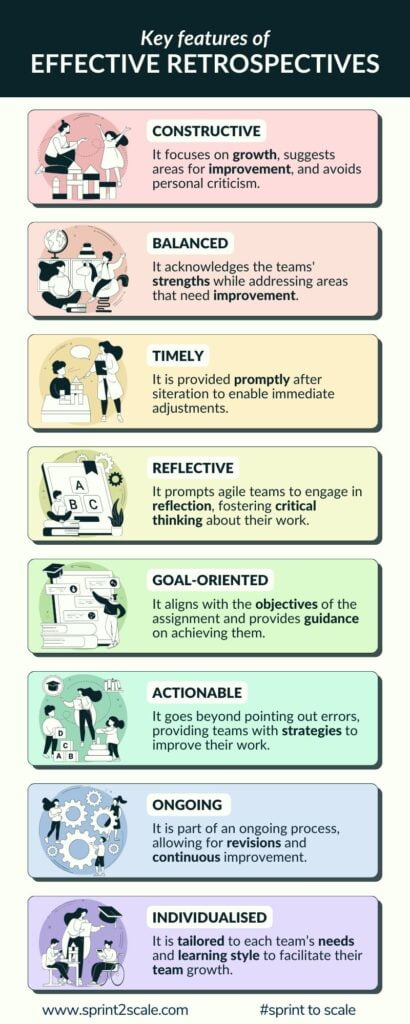
2.2 Purposeful Reflection
While other ceremonies address the ‘what’ of project development, the Retrospective delves into the ‘how.’ It takes a magnifying glass to the team’s dynamics, communication patterns, and the effectiveness of Agile processes. The essence lies not just in delivering a product but in optimizing the mechanisms employed throughout the journey.
2.3 Beyond the Metrics
The Retrospective goes beyond the quantitative metrics of completed tasks and sprint velocity. It aims to unravel the qualitative aspects of teamwork, collaboration, and adaptability. How did the team navigate challenges? What communication patterns emerged? These are the questions that find their answers in the reflective dialogue of the Retrospective.
2.4 Collaboration Amplified
The Retrospective creates a safe space for collaboration, inviting team members to share their insights, opinions, and concerns openly. It’s not just a ceremony; it’s a forum where every team member’s voice holds significance. Through this shared reflection, the team forges stronger bonds, understanding each other’s perspectives, and collectively owning the outcomes.
2.5 The Unwritten Lessons
In many ways, the Retrospective uncovers the unwritten lessons of a sprint. It dissects the tacit knowledge that emerges through collaboration, acknowledging the nuances that don’t make it to the formal documentation. By doing so, it ensures that the team doesn’t just repeat successes but evolves through the subtle lessons embedded in every sprint.
2.6 Continuous Improvement Catalyst
At its core, the Retrospective is a catalyst for continuous improvement. It’s the engine that propels teams towards betterment, sprint after sprint. By identifying what worked well and what could be enhanced, the Retrospective fuels a culture of learning, adaptation, and innovation – the hallmarks of Agile methodologies.
2.7 The Retrospective Ritual
The ritualistic nature of the Retrospective, often occurring at the conclusion of each sprint, contributes to its impact. It’s not just a sporadic event but a consistent practice, embedding the spirit of reflection into the DNA of the team. As the team adheres to this ritual, the reflective mindset becomes second nature, driving continuous improvement organically.
2.8 The Unveiling Journey
In the chapters to come, we will unravel the layers of the Retrospective, exploring its objectives in detail, dissecting common challenges faced, and proposing strategies to enhance its effectiveness. Join us as we shine a spotlight on the unsung hero, uncovering the nuances that make the Retrospective an indispensable element in the Agile toolbox. Together, let’s unveil the journey of reflection, collaboration, and continuous improvement embodied in the Agile Retrospective.
Chapter 3: Common Challenges with Retrospectives

3.1 Time Constraints: Racing Against the Clock
One of the common challenges that teams face during Retrospectives is the pressure of time. In the sprint-driven Agile environment, where every moment is accounted for, teams may find it challenging to allocate sufficient time to the Retrospective. Rushed retrospectives often miss the depth needed for meaningful insights, hindering the team’s ability to identify and address critical issues effectively.
3.2 Lack of Active Engagement: The Silent Participants
While the Retrospective encourages open communication, some team members may disengage or remain silent during the session. This lack of active participation can stem from various factors – a fear of judgment, a perception that their input is not valued, or simply a lack of understanding of the retrospective’s significance. Overcoming this challenge involves creating an inclusive environment where all voices are not only heard but actively sought.
3.3 Difficulty in Implementing Changes: The Actionable Dilemma
Identifying areas for improvement during the Retrospective is just the first step; the real challenge lies in implementing the proposed changes. Teams may find it daunting to translate insights into actionable items and integrate them into the next sprint. Without a clear plan for execution, the retrospective’s potential impact remains unrealised.
3.4 Mitigating Challenges: Strategies for Success
Allocating Dedicated Time |
|
Creating a Safe and Inclusive Space |
|
Setting Clear Action Items |
|
Periodic Check-ins |
|
3.5 The Transformative Potential
While these challenges may pose hurdles to effective retrospectives, they also present opportunities for growth and improvement. Addressing these issues head-on, teams can unlock the transformative potential of retrospectives, turning them from routine sessions into powerful instruments for continuous enhancement.
In the subsequent chapters, we will delve deeper into these strategies, providing practical insights and examples to guide teams in overcoming these common challenges. Join us as we navigate through the intricacies of the Agile Retrospective, unraveling the secrets to making this ceremony not only talked about but truly valued and impactful.
Chapter 4: Strategies to Overcome Challenges
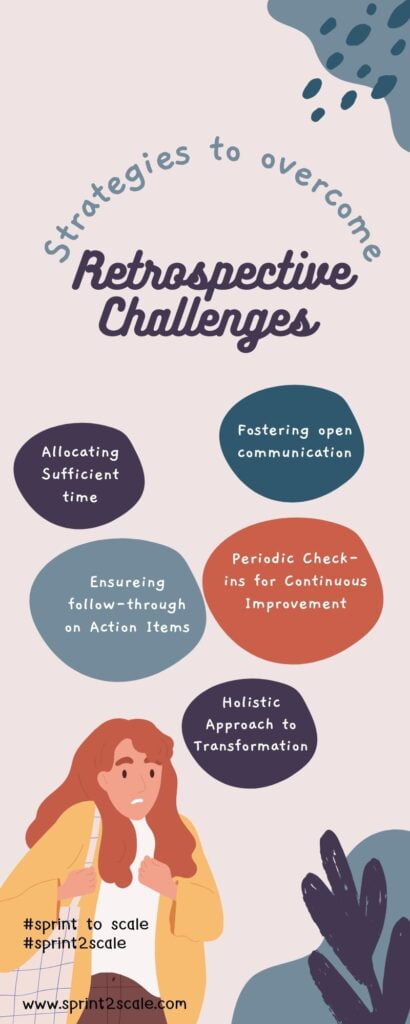
4.1 Allocating Sufficient Time
Challenge: The Time Crunch
In the fast-paced Agile environment, time is often a scarce resource, and the Retrospective may be perceived as a dispensable luxury. However, dedicating ample time to the Retrospective is paramount for extracting meaningful insights and fostering a culture of continuous improvement.
Strategies:
- Protected Time Slots: Allocate specific and protected time slots for Retrospectives, ensuring they are not squeezed between other ceremonies.
- Sprint Length Consideration: Adjust the duration of the Retrospective based on the sprint length, allowing for a proportionate amount of time for reflection.
4.2 Fostering Open Communication
Challenge: Lack of Active Engagement
Engaging all team members actively in the Retrospective can be challenging due to factors such as fear of judgment or a perception that their input is not valued. Creating an open and inclusive communication environment is crucial for overcoming this hurdle.
Strategies:
- Establish Ground Rules: Define and communicate ground rules that encourage respectful and inclusive communication.
- Anonymous Feedback: Use anonymous channels for collecting feedback during the Retrospective to encourage candid responses.
4.3 Ensuring Follow-Through on Action Items
Challenge: Implementation Hurdles
Identifying areas for improvement is only part of the process; the real value emerges when these insights are translated into actionable items and implemented. Ensuring follow-through on action items is vital for realizing the intended improvements.
Strategies:
- Clear Action Item Definition: Clearly define and articulate action items during the Retrospective, ensuring they are specific, measurable, achievable, relevant, and time-bound (SMART).
- Assigned Responsibilities: Assign responsibilities for each action item to team members, promoting accountability.
4.4 Periodic Check-ins for Continuous Improvement
Challenge: Sustainability
The effectiveness of changes implemented based on Retrospective insights may diminish over time if not periodically reviewed and adjusted. Implementing a system of periodic check-ins ensures continuous refinement and improvement.
Strategies:
- Scheduled Review Sessions: Plan regular review sessions dedicated to assessing the progress of previously implemented changes.
- Adaptive Approach: Be open to adjusting strategies based on the outcomes of these check-ins, allowing for iterative improvement.
4.5 A Holistic Approach to Transformation
Overcoming challenges in Agile Retrospectives requires a holistic approach that encompasses time management, communication dynamics, accountability, and continuous refinement. By implementing these strategies, teams can transform Retrospectives from routine rituals into powerful tools for sustained growth and improvement.
In the upcoming chapters, we will delve into real-world examples, showcasing how teams have successfully applied these strategies to overcome challenges and enhance the effectiveness of their Retrospectives. Join us on this journey as we unveil the potential for transformation within the Agile Retrospective process.
Chapter 5: Varieties of Retrospective Formats
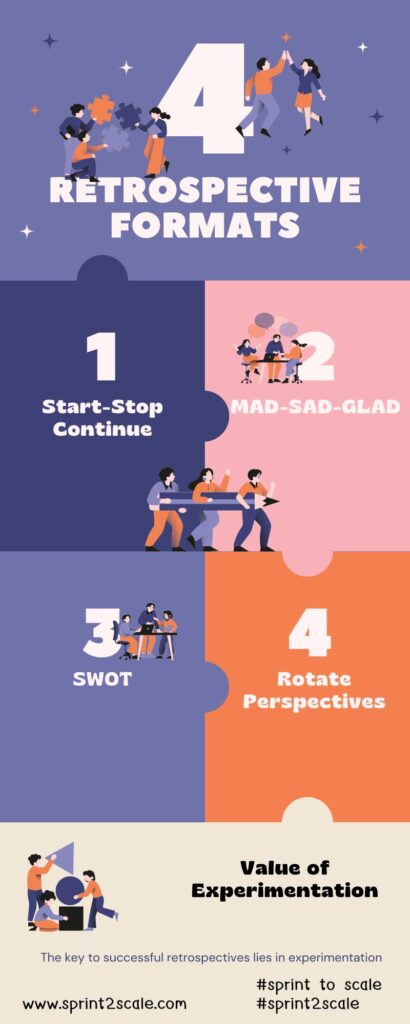
5.1 The Need for Variety
Agile Retrospectives thrive on creativity and adaptability. Employing diverse retrospective formats keeps the sessions engaging, prevents monotony, and addresses various aspects of the team’s performance and collaboration. Let’s explore some popular formats that add variety to retrospectives.
5.2 Start-Stop-Continue
5.2.1 Concept: In this format, team members collectively identify activities or practices they want to start doing, stop doing, and continue doing. It’s a straightforward yet effective way to assess what is working well and what needs adjustment.
5.2.2 Implementation:
- Provide sticky notes to team members.
- Ask them to jot down items for each category: Start, Stop, and Continue.
- Group and discuss the items to derive actionable insights.
5.3 Mad, Sad, Glad
5.3.1 Concept: This format taps into the emotional spectrum of team members, encouraging them to express what made them happy (Glad), what frustrated them (Mad), and what brought satisfaction or contentment (Sad).
5.3.2 Implementation:
- Create three sections on a board or virtual platform: Mad, Sad, Glad.
- Team members add sticky notes to each section, sharing their sentiments.
- Facilitate a discussion around each category to uncover themes and insights.
5.4 Strengths, Weaknesses, Opportunities, Threats (SWOT) Analysis
5.4.1 Concept: Adapted from business strategy, the SWOT analysis format helps teams assess internal strengths and weaknesses along with external opportunities and threats. It offers a comprehensive view of the team’s situation.
5.4.2 Implementation:
- Draw a matrix with four quadrants: Strengths, Weaknesses, Opportunities, Threats.
- Discuss and identify factors for each quadrant, considering both internal and external aspects.
- Use the insights to formulate strategies for improvement.
5.5 Rotate Perspectives
5.5.1 Concept: Encouraging team members to view the sprint from different perspectives fosters empathy and a deeper understanding of challenges. Perspectives can include roles (developer, tester, product owner) or even external stakeholders.
5.5.2 Implementation:
- Assign different perspectives to team members or let them choose.
- Discuss the sprint experiences and insights from each unique viewpoint.
- Identify cross-functional insights that contribute to a holistic understanding.
5.6 The Value of Experimentation
The key to successful retrospectives lies in experimentation. Teams should feel empowered to try various formats and adapt them to suit their unique needs. The variety of retrospective formats not only keeps the sessions fresh and engaging but also uncovers different facets of the team’s dynamics and performance.
In the upcoming chapters, we will delve into real-world examples, showcasing how teams have effectively applied these diverse retrospective formats to enhance collaboration, communication, and continuous improvement. Join us as we explore the art of retrospection with creativity and versatility.





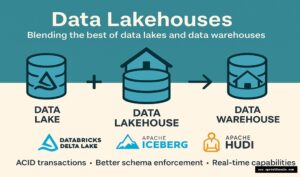
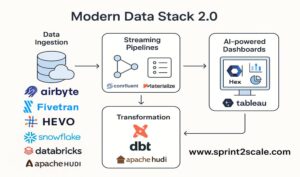
No Comment! Be the first one.